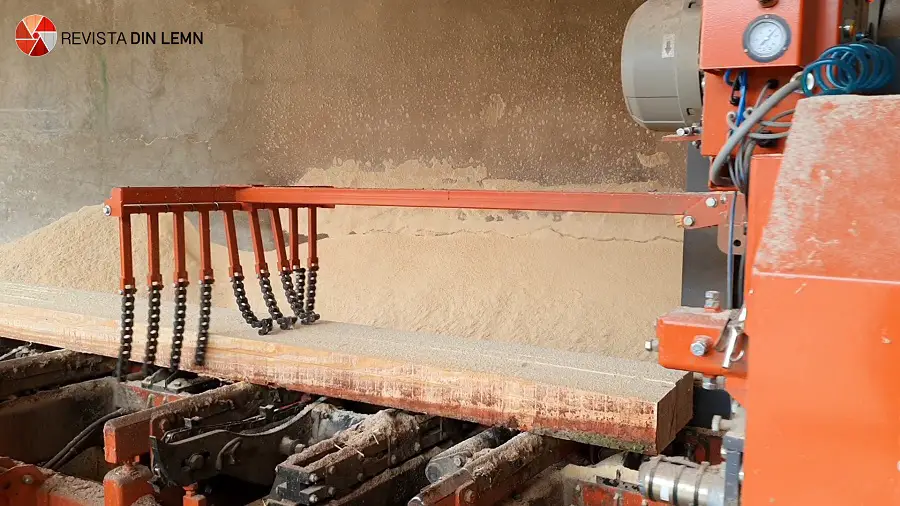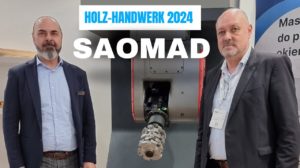I recently visited Lăcusta Prodcom, a logging and primary wood processing company in Cornu Luncii, Suceava. Discussions about logging, the fact that all those who cut and process wood are put on the same level, led us to visit such a company to see how logging is done, how and how much it is cut, how it is processed and where the wood from primary logging ends up. Wood-Mizer, a supplier of primary processing machinery, facilitated our meeting with Ionică Ștefănoaia, CEO and owner of Lăcusta Prodcom, with whom we chatted on a foggy October morning. It was a discussion about building a company, about work and hardship, about wood.

We arrived in Cornu Luncii at 8.30. We had spoken to Mr. Ștefănoaia about meeting in the morning, but the dense fog delayed us a little. It wasn't a problem because the same fog delayed him. He was coming back from somewhere in Neamt, where he had left at 3 a.m.. In the meantime we met the factory manager who had drunk us with apples picked in the morning and told us about the apples in the orchard like children.
Shortly after, Mr. Stefănoaia arrived and the discussion began to connect. He has that soft Bucovina tongue that makes anything he says sound like he's telling a story. You'll see and hear him in the video at the end. He's friendly and open, nothing like I imagined a logging person to be. He knows all about the company's business, the machinery, the primary logging and processing, the permits and approvals, the price of timber and the countrywide requirements. He answered our questions, told us his wishes and desires.
Start
The company started its activity in 1994 with logging, but development came with the purchase of the first Wood-Mizer saw in 2006. Until then, they cut wood bought from Romsilva and sold it as logs or firewood. Machinery was scarce, they worked a lot with old logging methods, and activity was quite low. By 2006 it had grown to 7 employees. At that time he could have hired at any time, there were lots of people coming to the gate asking him if he wasn't hiring. But he didn't have to. There were enough for all the activity.
He understood that only by cutting and selling logs to furniture factories he could not grow and he wanted to buy a machine with which he could make good quality timber for factories or the construction industry. In 2006 he came to Bucharest to the BIFE furniture and equipment fair, where he saw the T 300 saw for the first time. It was love at first sight. He kept going back and forth, circling around it, and the Wood-Mizer people caught his interest. After all the discussions and even though he told them he didn't have all the money, they sent the saw to Suceava. Like any serious Bukovinian, he immediately went to the bank, did all the documentation and in less than two months he paid it off.
At that time there was only one other similar machine in the area, in the Bistrita valley. He went there with an employee to watch it work. He saw that it wasn't difficult, they went back home and in a month they got used to it. He started cutting logs into planks, poles and beams, and so the workload increased rapidly. He had to hire two more men. With the T300 saw from Wood-Mizer and the two extra men, he was now doing triple production. He was thus able to increase both production capacity and product value.
The desire to add value to timber has led to other machinery purchases
Then he got brave and bought more machinery; he got a tractor, bought cars to transport the timber, hired more people; he organized the place where he operates better - an old flax-melting mill. But then the crisis came and things stagnated. Even though he still wanted machinery, he didn't have the courage to take on even more bank debt.
After the crisis, however, in 2013, he bought his second Wood-Mizer, an LT 70 saw. It was more powerful, with an automatic log loading conveyor and a timber removal conveyor. He was getting quality products and started exporting. He exported by his own forces to nearby countries (Greece), but to send to Arab countries he used export companies. The infrastructure needed to send timber by sea was impossible for such a small firm to sustain.
In 2015 he also got a Wood-Mizer saw for thin wood - LT15 - which he uses less often, and in 2019, the new Wood-Mizer saw, WM 4000. He bought this one at a more difficult time for the export business. In Europe, a bark beetle had appeared in the softwoods and the wood was massively cut down. The softwood market was flooded with green wood and the price fell sharply. He realised then that if he processed more wood, his chances on the market would be better.
Challenges and future plans
Ionică Ștefănoaia tells with sadness that people eager to learn a trade are disappearing, that it is increasingly difficult to find people who are willing to work and be responsible, and that the press reports put all mining companies in the same pot. But they also have problems with the big companies that buy a lot and control the price of timber. When you have 0.11% market share at country level, it's hard to get a foothold. Romsilva and the private forestry offices are the owners of the timber, the ones who sell it at auction. Companies bid for the amount they can harvest, buy it, cut it and process it. It knows that in order to cope with competition and the rising price of timber, the level of processing must increase. That's why he plans to buy a kiln. That way, the timber he sells will fetch a better price.
It now employs 37 people, is continually on the job, and has a hard time finding people to hire. He has even considered bringing in outsiders, but it's a difficult field that requires training. He is trying to do everything more efficiently, to harvest the wood with as little waste as possible using high-performance machinery. He would like the wood to stop being exported as logs and instead be processed here to add value. He knows that it is impossible to process all the wood to the furniture stage, but at least it should be processed to the most advanced stage. He thinks about the future in terms of investing in technology to increase the value of wood.
After half a day spent in Cornu Luncii I understood the role that such exploitation companies play in the furniture and construction industry. Without them, solid wood furniture would not exist. Neither would the wooden roof timbers and rafters, windows, doors and staircases or the beams and cladding in the attic. But we do need sustainable forestry, country-wide reforestation programmes, and a fight against theft and corruption. It is not a total halt to logging that is the solution in a country with a tradition of timber processing and a major timber industry, but rational and conscious logging that will not harm us, the planet or those who will come after us.



























It is hard to understand this. if properly exploited, the forests would bring a nice income. last month I went to a private forestry farm to buy firewood, where 3 ha of forest had been cut down for replanting (the predominant species was poplar and it was considered unprofitable, they want to plant ash and oak, the forest being in the countryside). Among the felled trees there were also some secular oaks (diameter over 1.2m m at the base) and I was stuck when I saw that they cut them for fire. it was healthy wood, cut wood for table tops would have been worth as much as all the wood on the 3 ha. it's a pity that we don't know how to value what we have, I see many who put nuts on fire. It's true, it's more dangerous to carry a piece of log than drugs. If I want to give my aunt some of the wood I bought, I can only walk around like a thief... because I don't have any papers and I can't get any.
[...] About logging and primary processing with Ionică Ștefănoaia from Lăcusta Prodcom [...]